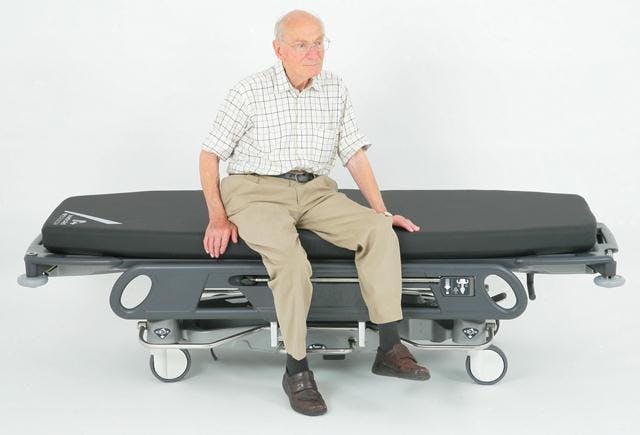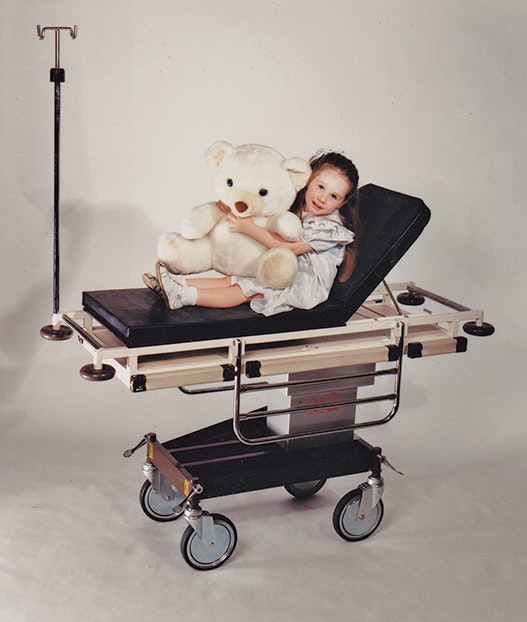
This year, British clinical equipment manufacturer, Anetic Aid, is celebrating quite a milestone: for it is 50 years since the roots of the company were first established by an enterprising engineer who spotted an opportunity to open a workshop fabricating stainless steel medical furniture in Hampshire on the south coast.
There were no sophisticated electronics or space-age materials back then – but the principles of good design and high-quality manufacture were there at the outset, just as they are today.
The man behind the great idea was Ivor Schofield, the late father of current Anetic Aid CEO Guy Schofield. Ivor, a Chartered Mechanical Engineer, had experience in aeronautical and naval businesses, latterly as Joint Controller of Engineering. But that wasn’t enough for Ivor: he wanted his own business – the chance to realise his potential and use his flair for design, his engineering expertise, drive and determination to overcome obstacles and take an idea from the drawing board through to a practical solution in the real world.

Another major piece of the jigsaw was his relationship with fellow entrepreneur, Tom Brady, who was already selling the medical furniture as part of a range of instruments and other medical supplies.
It was Tom who coined the name ‘Anetic Aid’ when they forged a business partnership which was to last until Tom passed away in 1993. Like any emerging company, there were good times and tough times in the early days – and the big break came in the early 90s when the company’s collaboration with King’s College Hospital produced Britain’s first dedicated Day Surgery Trolley.

How the QA4 Mobile Surgery System evolved
Called the ‘KCH’ after the hospital where it was developed, it was the forerunner of the QA4 Mobile Surgery System, which is seen today in hospitals all over the UK – and increasingly across the world.
But back then, same day surgery was very much a new concept: with six specially designated theatres, it was the biggest unit in Europe and visitors from all over the world came to look at the King’s College Hospital approach to Day Surgery.

A pioneering group led by surgeon Mr Paul Baskerville was behind the project – as he told Anetic Aid back in 2013: ‘I had been Registrar to Mr Paul Jarrett, one of the founders of the British Association of Day Surgery (BADS) and was convinced that Day Surgery was the way forward. Getting funding to build a new unit of this kind was a tremendous opportunity.
‘In order to drive efficiency, we looked at two particular aspects – the first was to have all of the nursing staff able to work everywhere in the unit on rotation, which required a specialist training programme.
‘The second was to find a way of abolishing the practice of transferring patients from bed to trolley, trolley to operating table etc. – and that is what led to the idea of a piece of equipment that could be both transport trolley and operating table.’
Paul Baskerville and Jill Solly, who was Day Unit Manager at the Trust at the time, were part of a small group tasked with equipping the whole of the unit, so they set out to find a manufacturing partner who had the skills and vision to develop their idea of a dedicated day surgery trolley.
Guy Schofield had recently joined the family business at its manufacturing site in Portsmouth and he led the project – drawing up the initial brief and working alongside Anetic Aid’s designers and engineers to create the first prototypes. In all, it took around 18 months to develop, and in 1991 when the Day Surgery Unit opened, the new equipment was ready – and the rest, as they say, is history.
Harnessing new technologies and materials
And of course, there have been many other innovative projects too: Anetic Aid started supplying tourniquet systems in the 80s, another item of equipment which has radically changed technologically.
Back then they were pneumatic – while now, Anetic Aid’s AT4 is a standalone, state-of-the-art electronic tourniquet system with integral air supply, long-life batteries, OLED displays and inbuilt self calibration and safety features.
And the company never stands still: some of the most recent innovations have all been about adding powered functions and inbuilt drive to trolley systems.
Designs to reduce work-related musculoskeletal disorders within the healthcare sector
The incidence and impact of musculoskeletal disorders (MSDs) amongst healthcare staff has been a key concern for NHS managers and practitioners alike for many years.
In fact, it is believed that work related MSDs – which include manual handling injuries – cost the NHS in the UK £400 million each year, and account for as much as 40% of all sickness absences.
And with the number of bariatric patients are on the rise, and patient’s weights generally increasing, it seems that the problem is here to stay.
So, in recent years, Anetic Aid’s designers have been focused on evolving products that combine manoeuvrability with powered assistance.
All the latest models of the QA4 now have powered functions as standard, raising and lowering the platform and backrest, as well as traverse and lateral tilt.
And in 2016 there was a major advance with the company’s flagship product - the QA3 Patient and Emergency Stretcher. Models of the QA3 can be found in more than 90% of NHS hospitals across the UK – and it is known for its manoeuvrability and reliability. But our engineers took this to a new level with the incorporation of an inbuilt motorised drive function, offering controlled, effortless travel up to gradients of 10°. This was in addition to powered functions including KneeFlex and a button to swiftly and automatically return the trolley to a horizontal, optimal height position for CPR treatment.
The most recent addition to the company’s portfolio is a dedicated Ophthalmic Stretcher which combines all of the innovations of powered positioning with a specially designed dual-articulating headrest.
Said Anetic Aid’s CEO Guy Schofield: ‘We are constantly striving to take our products to the next level, and the introduction of powered positioning for trolleys and stretchers was a very natural progression in engineering terms. The integration of the controls and electronics for a ‘drive-assisted’ function was far more complicated. We had to create a system that was intuitive for the user, offering virtually no effort to move the trolley, while still giving them full control. Add to that, it was important to retain aspects like good ground clearance and excellent manoeuvrability – so a challenge indeed - and I am really proud that we have achieved it!’
And Sales Director Andrew Curtin (who has been with the company for nearly 40 years) added: ‘Adoption of same-day surgery has increased steadily over the past 25 years - from 15% to 70% in the United Kingdom between 1989 and 2003 alone. Although a challenge for some, it is increasingly seen as the way forward, and we like to think we have played our part in that. With the ever-present pressure to reduce waiting times, it is one way Trusts can expand the number of procedures they carry out because of the increased throughput it allows – and of course there are the added benefits of reduced lifting and handling for patients and practitioners alike.
‘One recent success story we learned about came from Rotherham NHS Foundation Trust. They use our QA4 Mobile Surgery System, and a recent move to make day case the default approach to many elective procedures – including those in main theatres – has enabled the team to increase the annual number of day cases from 4,000 to 6,000.
‘In all, the last 50 years have been quite a journey – both for us and our many clients. Anetic Aid was still the ‘new kid on the block’ when I joined back in 1983, working out of an old, converted chapel in Guiseley. My colleagues and I have always taken great pride in promoting innovative UK designed and produced products – we’ve certainly come a long way!


